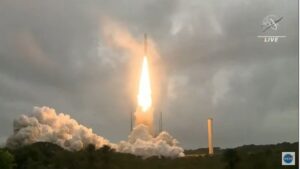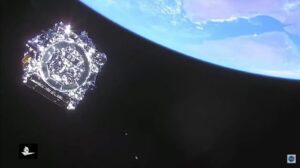The James Webb Space Telescope, which has taken itself millions of aspirations and hopes, is finally got launched at 12.20 pm GMT (7.20 am EST) on Christmas Day from French Guiana on an Ariane-5 Rocket, to create a history for the field of entire astronomy and science.

Also, Its live broadcast is enabled to see directly with the help of the below-mentioned link. If you still have not had a look over its marvelous launch, you must hit it up!
Hindrance Faced By James Webb Prior To Its launch
It was indeed quite devastating that the unimaginable launch of the $10 billion observatory, had to face plenty of impediments in the form of constant postponements, mainly due to severe weather conditions at the position of its launch, also, it got much bothered by a peak time disturbances. Read the Strange Facts Based On James Webb Space Telescope
Incredible Press Conference Held: Delight After James Webb Telescope Launch
As soon as NASA’s Largest and versatile James Webb Space Telescope was successfully launched, the space agency and its collaborated partners have held an incredible press conference, to dedicate huge respect to the early launched Webb telescope.
The press conference was begun by 9 a.m. EST (1400 GMT) and has involved the senior-most heads of space agencies, who has designed James Webb including leading mission scientists.
The Ambition Of James Webb Space Telescope
The James Webb Telescope, which has gained millions of attention over it, has a stern and rigorous ambition to see back 13.7 Billion Years in time for stars and respective galaxies formed during the early phase of the entire universe.
Complete Overview on James Webb Space telescope
Words Dedicated to James Webb From Seniors
With the very first appreciable words, NASA administrator, Bill Nelson has stated in respect of James Webb Space and Science Telescope that:
It’s a great day for planet Earth!
– NASA’s Administrator Bill Nelson
Also, so many enormous words were dedicated to the World’s Largest James Webb Space Telescope, in which of them are:

We are going to discover incredible things that we never imagined. The accolades are pouring in from the space agencies who worked together to put the space telescope together!
-NASA TV (Words For James Webb in Interview after Launch)
Current Location Of The James Webb Space Telescope
NASA’s James Webb Space Telescope has received its triumph landing in space, beginning from a month-long trek to L2 Point, approximately 1 Million Miles (10 Lakh Miles) from the Earth.
NASA’s James Webb Space Telescope has safely and successfully got dropped by its Launchpad Rocket, Ariane-5, and finally deployed its solar array to frame a smooth and flawless journey into space!
Its Correlative Camera hold on the Ariane-5 rocket, allowed us to have live stage beamed views of the awe-inspiring event!
Heart Brimming Moment: ‘Go, Webb, go! was cheered up from Arianespace launch control at the Guiana Space Center in French Guiana.
What Is L2?
A great French Mathematician, significantly known as Philip Lagrange, has simplified the three-body problem in the 18th century. The problem arises that, Is there any certain arrangement in which three bodies can revolve together without changing their current position?
Subsequently, It came up that this equation may have five perfect simplifications, which will later, known as five Lagrange points significantly.
Significance Of Lagrange Points (L2)
Lagrange points are geographically most stable locations where spacecraft can ‘settle’ for a long time even retaining their position without burning fuel!
The gravitational attraction of two masses is equivalent to the centripetal force required for a mass to travel with other bodies at different Lagrange points.
Complete Overview on Hubble Space Telescope
The Lagrange points are namely, L1, L2, L3, L4, and L5, in which the points L1, L2, and L3 are in the same line while L4 and L5 are located as equilateral triangle points in the space.
Extraordinarily interesting!
Thanks a lot sir, Keep supporting.
Another big difference between the James Webb Space Telescope and the Hubble Space Telescope is that JWST will orbit the sun, whilst Hubble orbits Earth. JWST will be too far away to be serviced, unlike Hubble which was accessed and serviced by space shuttle missions. Not everyone is happy with the choice of name for the space telescope. An online petition was set up by critics urging NASA to rename the telescope due to claims that Webb was complicit in discrimination against gay and lesbian NASA employees during his tenure. NASA has since said it will not rename the telescope despite complaints.